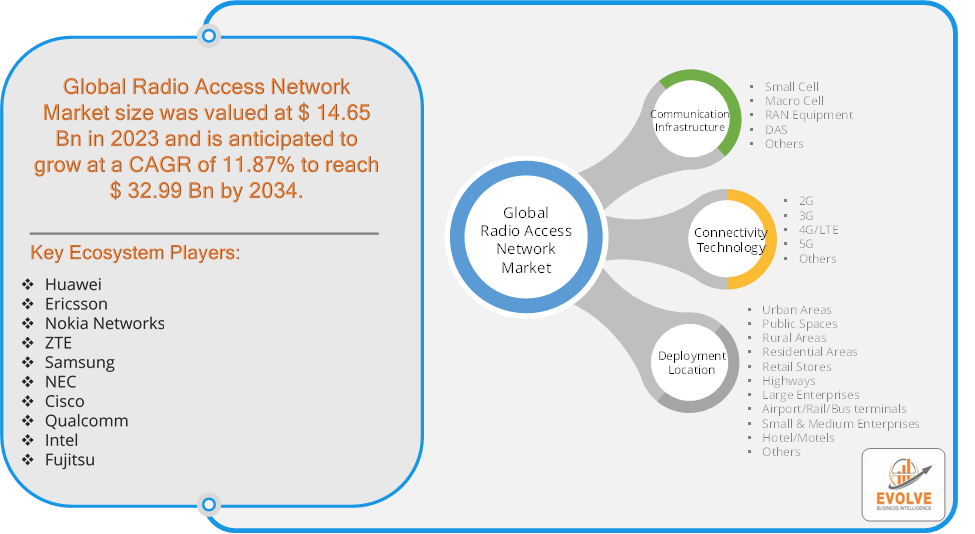Radio Access Network Market Surges: 11.87% CAGR

Evolve Business Intelligence has published a research report on the Global Radio Access Network Market, 2024–2034. The global Radio Access Network Market is projected to exhibit a CAGR of around 11.87% during the forecast period of 2024 to 2034.
Evolve Business Intelligence has recognized the following companies as the key players in the global Radio Access Network Market: Huawei, Ericsson, Nokia Networks, ZTE, Samsung, NEC, Cisco, Qualcomm, Intel and Fujitsu.
The Global Radio Access Network Market is projected to be valued at USD 32.99 Billion by 2034, recording a CAGR of around 11.87% during the forecast period. The Radio Access Network (RAN) Market refers to the global industry focused on the development, deployment, and sale of technology and infrastructure that enable mobile devices to connect with telecom networks. The RAN is a crucial component of wireless communication systems, primarily responsible for transmitting data between mobile devices (such as smartphones and IoT devices) and the core network.
The market is driven by the rise of 5G technology, increasing data traffic, and demand for high-speed and low-latency communication services. The RAN market is a dynamic and rapidly evolving sector that plays a vital role in our connected world.
Download the full report now to discover market trends, opportunities, and strategies for success.
Segmental Analysis
The global Radio Access Network Market has been segmented based on Communication Infrastructure, Connectivity Technology and Deployment Location.
Based on Communication Infrastructure, the Radio Access Network Market is segmented into Small Cell, Macro Cell, RAN Equipment, DAS and Others. The Small Cell segment is anticipated to dominate the market.
Based on Connectivity Technology, the global Radio Access Network Market has been divided into 2G, 3G, 4G/LTE, 5G and Others. The 5G segment is anticipated to dominate the market.
Based on Deployment Location, the global Radio Access Network Market has been divided into Urban Areas, Public Spaces, Rural Areas, Residential Areas, Retail Stores, Highways, Large Enterprises, Airport/Rail/Bus terminals, Small & Medium Enterprises, Hotel/Motels and Others. The Urban Areas segment is anticipated to dominate the market.
Regional Analysis
The Radio Access Network Market is divided into five regions: North America, Europe, Asia-Pacific, South America, and the Middle East, & Africa. The RAN market in North America is primarily driven by early 5G deployments and the strong presence of major telecom operators like Verizon, AT&T, and T-Mobile. The region is also home to significant investments in private 5G networks, particularly in industries such as manufacturing, healthcare, and defense. Europe is witnessing a steady transition to 5G, with countries like Germany, the UK, and France leading the charge. The adoption of Open RAN architecture is supported by EU regulations aimed at promoting vendor diversity and reducing reliance on single suppliers. The Asia-Pacific region leads the RAN market, driven by rapid 5G rollouts in countries like China, South Korea, Japan, and India. China, in particular, has aggressively invested in 5G infrastructure, deploying millions of base stations to support both urban and rural connectivity. The Middle East is experiencing a steady growth in the RAN market, driven by 5G deployments in countries like Saudi Arabia, the UAE, and Qatar. The region is focused on digital transformation, smart city projects, and 5G-enabled services in areas like oil and gas, tourism, and logistics and In Africa, there is increasing demand for 4G and 5G networks to enhance rural connectivity and bridge the digital divide. Telecom operators are focused on expanding network coverage to previously underserved regions. The RAN market in Latin America is growing as countries like Brazil, Mexico, and Argentina begin to roll out 5G networks. There is also increasing demand for private networks and IoT connectivity in sectors like manufacturing and agriculture.


